Are you considering building an outdoor deck? You must already have a fabulous picture made up in your imagination.
Now, when you came out of daydreaming and begin to plan on constructing one from the scratch, everything seems like a hectic task. A plethora of matters to think about and take into consideration. And, one of those matters includes ‘which wood should I choose?” Don’t worry! This we can help you with.
While searching for the best wood for decking, you will be bombarded with so many options – softwood, hardwood, composite, pressure-treated wood, and so on.
But, before jumping into browsing for different woods, have a basic understanding of your priorities. When choosing a wood, there are mainly three points you have to keep in mind;
- Climate
- Aesthetics
- Budget
Which Is the Best Wood For Decking?
There are no ‘One wood species that fits all! With your priorities in mind, go through the list of the best 10 kinds of wood for the deck we have assorted here for you.
1. Ipe Wood (Extremely Durable)
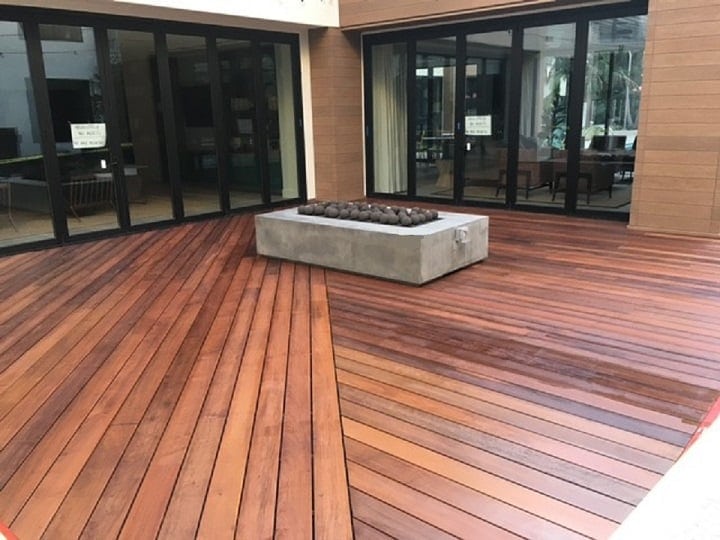
Ipe (pronounced ee-pay) or otherwise known as ‘Brazil nut’ is one of the most used wood for decking. You might have come across this name during your initial search.
Ipe is an extremely hard and strong wood native to Central and South America. It is known for a lot of preferable, good qualities.
Reasons To Choose Ipe Wood For Decking
Let’s have a look at the advantages Ipe can offer,
1. Durability
You would want your deck to be there for decades, right? Ipe has incredible longevity. It can last for more than 50 years in the best-case scenario. It is naturally rot-resistant. Unlike the other woods, it does not enlarge or reduce in size due to temperature changes. Ipe is an excellent wood that suits all climates.
Do you know that Ipe has a Class A fire rating? As equal to concrete or steel!
2. Aesthetics
Ipe color varies from a unique dark brown to blacker-brown. It can give you a surreal, marvelous look at your deck.
3. Low Maintenance
Since Ipe is bestowed with a natural resistance against mildew, fire, and insects, it takes away the pain of arduous maintenance from your hand. Regular maintenance like moping is also effortless with Ipe.
The surface of the Ipe decking may oxidize and turn into a grey color over time. But, with proper annual maintenance (eg: applying brown patina), you can effortlessly prevent it.
Reasons To Avoid Ipe Wood
So far, we have been through the pros of Ipe, but there are several cons you should also be aware of,
1. It’s Expensive
The demand and its popularity have made this wood very costly. Factoring in the durability of the wood, it is worth the money for sure.
On average, the cost starts at $10 per square foot for ipe.
2. The Installation Will Be Difficulty
Ipe, as we have discussed, is dense and heavy. This makes the installation process difficult and special tools will be needed to cut the material
Though the upfront costs for ipe are on the higher side, it is one of the best options in wood for decking owing to its features.
2. Acacia Wood (Affordable & Easy To Work)
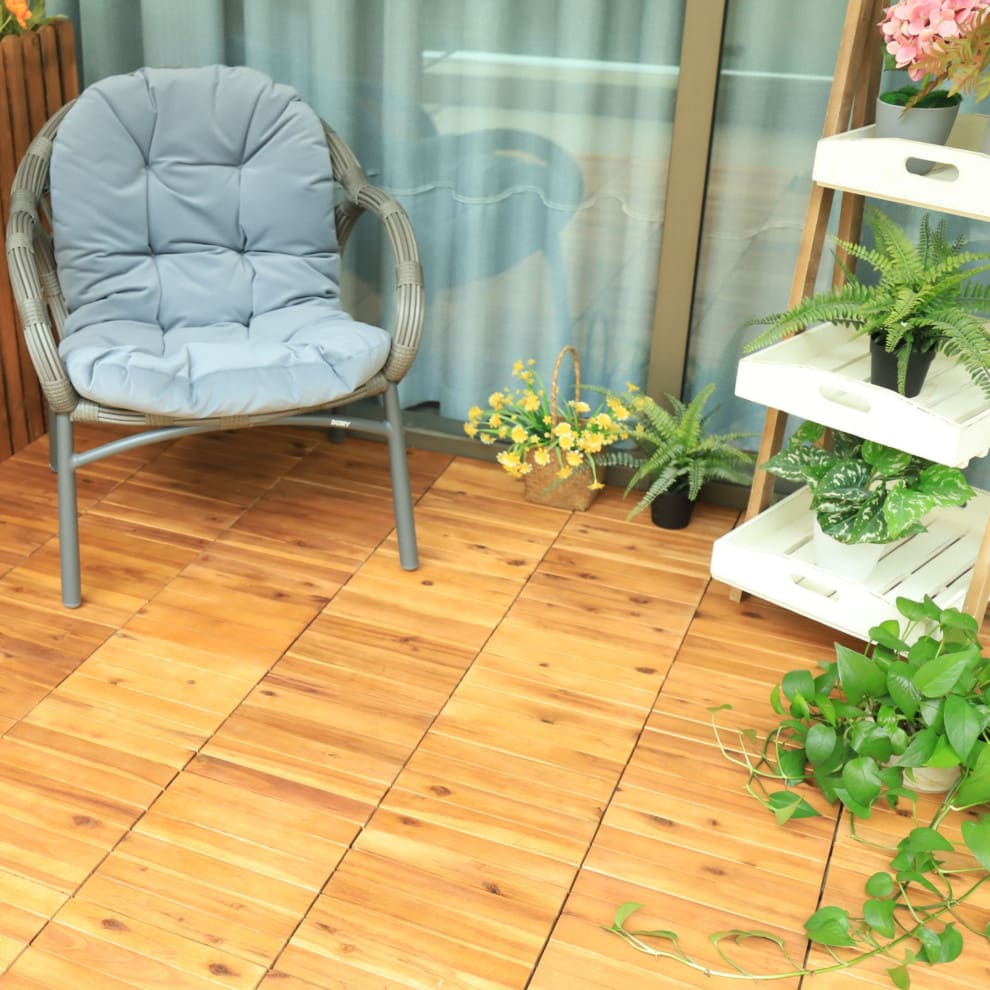
Acacia is a group of shrubs & trees. If you have this wood in your mind for your decking, go through this list of advantages and disadvantages we have summed up for you.
Reasons To Choose Acacia Wood For Decking
Acacia or wattles have several pros; which include,
1. Relatively Low Price
Compared to mahogany or ipe, acacia is very affordable. But, if you had maple or oak in mind, the price is still on the higher side.
It costs around $ 4 to $8 per square foot, but the price may vary for engineered floorings.
2. Dense & Durable
Acacia wood is the hardest hardwood thanks to its density of the wood. With the right maintenance, acacia can last for decades. Since its resistant to scratching, wear & tear, it is very suitable for outdoor decks.
3. Workable
Most of the hardwoods are tricky to work with and this is where acacia comes to the rescue. Freshly cut acacia is easy to cut and can be bent and made into any shape you want it to be.
4. Sustainable
Acacia is highly abundant. You can find this tree in Australia, Africa, and Asia. It does not need any fertilizer and is adaptable to any soil. So, if you are looking for a sustainable option of hardwood, acacia passes the test.
5. Naturally Water & Rot-Resistant
Your outdoor deck wood should be weather-resistant and that’s a must. Acacia is good for wet or humid climates and doesn’t absorb much moisture.
Reasons To Avoid Acacia Wood
Now, let’s talk about the drawbacks of this wood.
1. Sensitive to temperature variations & extreme moisture
Acacia cracks and warps when subjected to temperature fluctuations. This might make it unsuitable for places where significantly varying temperatures are observed.
Acacia wood also swells when placed in extreme moisture and humidity.
2. Requires heavy maintenance
If you anticipate a lot of spilling in your deck, acacia is not the best option out there. With acacia wood as your decking material, you should be on your feet to mop out every time you spill something on it to avoid swelling the wood.
Regular oiling is also mandatory to avoid any moisture issues.
3. Teak Wood (Resistant To Water & Moisture)
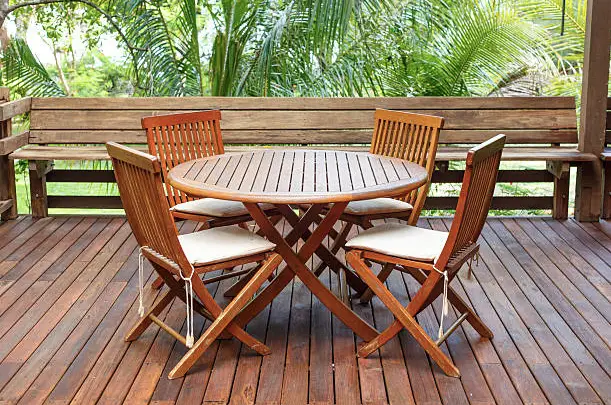
Teak (Tectona grandis) is one of the most preferred options of wood for outdoor decking. And, it is called the king of woods. Why? Let’s find out.
Reasons To Pick Teak Wood For Decking
1. Durability
Teak timber has a dimensionally strong structure. This prevents the wood from warping or bending like any other wood. The chances of cracking & splintering are also comparatively less in teak.
2. UV, Insects, Mold, and Moisture Protection
Teak material contains an abundant amount of natural oils & tanning. These substances bestow several advantages to the wood. It naturally repels mold, fungus, and rot, along with giving protection from UV & moisture.
Moreover, teak has good resistance to extreme cold & heat.
3. Appearance
‘Beauty lies in the eyes of the beholder and it’s true. The consensus when it comes to the aesthetics of teak is that it has a fine & elegant appearance.
The golden brown color tones will enhance the beauty of your deck. In later stages, it may turn into a silver patina. If you are not a fan of the same, you can get its original color with light sand and polish.
Reasons To Avoid Teak Wood
Does teak seem like a good option for your deck? Hold your horses. It’s the time to think of its drawbacks now,
1. Expensive
Well, the king has to be expensive! Teak wood decking material may cost around $ 10 to $ 15 per square foot, Its superiority puts it on the higher end of the price spectrum.
2. Availability
Teak is very hard to procure. It is partly because it grows slowly. The demand is another reason for its unavailability. Since it’s a slowly growing timber, ecologically, teak decking is not a sustainable option.
4. Red Wood (Resistance To Warping & Splitting)
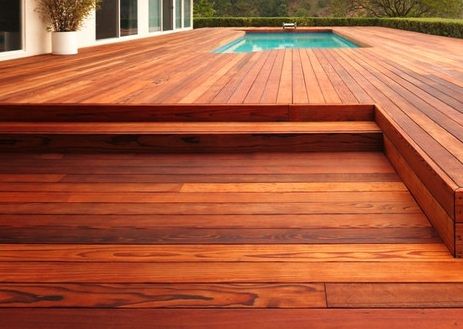
Redwood (Sequoia sempervirens) is another highly considered option for decking. This wood was preferred predominantly in the ’70s and ’80s, mainly due to its visual appeal. It has a reddish-brown color and a fine straight grain.
Now, as we have been let’s just talk about the pros & cons of this timber so that you can make an informed decision.
Reasons To Choose Red Wood for Decking
The major advantages of redwood are,
1. Durable
With proper maintenance, redwood can last for three decades. Redwood is resilient to decay; it can moderately resist wear and tear and can give a timeless look.
2. Insect & Fire Resistant
Redwood is highly fire-resistant. The tannins in the wood make it repellent to rot and insects.
However, keep in mind that tannins are not evenly distributed in redwood, and per-stain or sealing would be much required before installation.
3. Handy
Redwood being a softwood is light weighted, hence it is easy to move around. You can easily cut, saw, and drill this timber. In conclusion, redwood is easy to work with.
Reasons To Avoid Red Wood
Before you have your hopes high up, let’s consider the disadvantages also,
1. Require Yearly Maintenance
Redwood reacts to metal and stains pretty easily. It also loses its vibrance over time. If you would like to keep your deck alluring, yearly maintenance is a necessity.
2. Easily Acquire Dents
The soft composition causes dents and dings in the redwood fastly. The wear and tear may make your deck look less appealing over time.
3. Relatively Expensive
Redwood costs around $4 to $11 on average. If this price is relatively okay for you, then this wood is an option worth weighing in.
5. Tiger Wood (Unique Appearance)
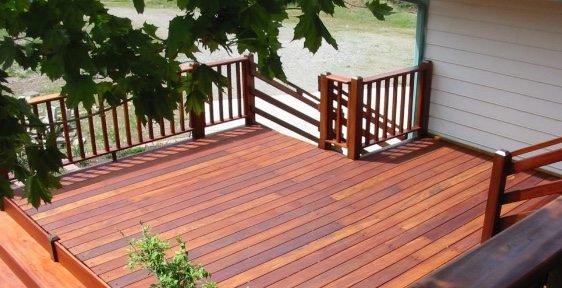
Tiger wood (also known as Brazilian Koa or Goncalo Alves) can give a stunning look to your outdoor deck and make you want to spend more time outdoors. Tiger wood, as the name hints, has a pattern analogous to tiger stripes. It has deep brown with streaks of black in between.
Reasons To Choose Tiger Wood For Decking:
Aside from its aesthetics, what more can this wood bring to the table?
1. Longevity
Tiger wood is naturally resistant to rot and decay. It can last up to 30 years if you are maintaining it the right way. Tiger wood doesn’t attract mold and moisture. This is a good timber if you have a damp environment. Once tiger wood is dried, it wouldn’t budge or shrink.
2. Resistant To Scratching
Since it is one of the hardest wood, it will provide resistance to scratching. With this in mind, you wouldn’t have to worry about your pets, heavy foot traffic, or furniture.
3. Easy to Maintain
You can clean the tigerwood decking by mopping or just by dusting. Whoosh! The surface is clean.
Reasons To Avoid Tiger Wood
So, now what are the cons of this gorgeous wood?
1. Relatively Expensive
Tigerwood costs around $7 to $15 per square foot. So, if this cost wouldn’t cause a hole in your wallet, you can go ahead with this option.
2. Not a DIY wood
Tigerwood is moderately difficult to work with. You’d want a professional to handle your decking construction.
3. Color fades over time
If you were after tigerwood just for its looks, you may be disappointed after some years. The lighter shades of it may get darker over time.
4. Ecological Impacts
Overlogging of trees to get timber has a major detrimental effect on the environment. This is the reason behind its unavailability in the market. Tigerwood currently has the highest market value. Combining both reasons, it has become a rare commodity to procure.
6. Pressure-Treated Lumber (Affordable & Durable)

Pressure-treated wood is a popular option out in the market for decking. Pressure-treated lumber is nothing but wood incorporated with protective chemical preservatives by pressure & vacuum technology to enhance its properties.
Reasons To Choose Pressure-Treated Wood For Decking
It has numerous advantages of its own:
1. Affordability
Compared to other decking materials, this choice is very affordable. Including installation, pressure-treated wood decking price would be in the range of $15 – $25 per square foot and making it a finer option for small-budgeted decking construction
2. Durability
As it is chemically treated, it has higher insect & rot repellency. Pressure-treated lumber withstands tear & wear.
3. Versatile
The dimensional structure of the wood lets easily stain or paint any color you like. And, if any dent or bent occurred, it is very easy to repair.
Reasons To Avoid Pressure-Treated Wood
Pressure-treated lumber is not a disadvantage-free option. It has a few drawbacks:
1. Deteriorate Easily
If not given the utmost care, PT wood will splinter easily. Most people have witnessed their PT decks getting dried and splitting apart due to climate changes.
2. Heavy Maintenance
Exposure to sunlight, ultraviolet rays specifically, can dim the color of the wood. This along with other reasons demand the application of penetrating sealer annually to the wood. The application of water sealant on an annual basis is also part of its maintenance.
3. Hazardous to the Environment
The chemicals in the PT wood are harmful to humans & the environment. It is highly advised to avoid frequent contact of PT wood with water and food.
7. Cedar Wood (Naturally Resistant To Rot & Insect)
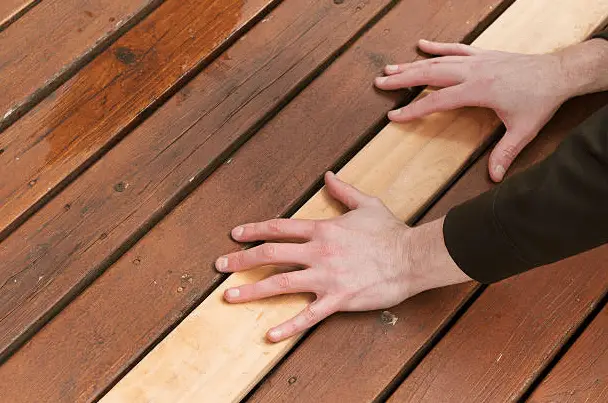
Cedar mostly comes from the coast of the Pacifica northwest. It has a long history of being used as a decking material. This very attractive wood with strong color tones is considered to be a great choice for outdoor decks.
Reasons To Choose Cedar Wood For Decks:
The advantages of cedar are,
1. Durable
Cedar deck can happily live up to 15-20 years. It is resistant to rot, moisture absorption, and insects. It does not warp or split as easily as the other woods.
2. Stability
Cedarwood has a porous internal structure. Usually, when moisture or humidity enters any wood, it leads to splits and cracks. Whereas due to cedar’s unique porous structure, it can easily expand and contracts with the humidity, and adjusts accordingly. This helps cedar wood in avoiding any wood checks
3. Environment-friendly
Cedar wood is easily renewable & biodegradable. It is obtained from sustainably managed forests.
Reasons To Avoid Cedar Wood
So, let’s now get to the cons or drawbacks of cedar wood.
1. Fragile
Do you have pets or a curiously destructive kid? Then, you need to think a little more about choosing cedar for your decks. Why? Because cedar is sensitive to pet claws and will even get scratched by furniture.
2. Heavy Maintenance
Cedar required staining and sealing annually. The color will degrade more quickly and you’d also need to take care of it every year.
3. Relatively expensive
You would have to spend around $25-$30 per square foot for cedar decks. If that amount is fine for you, then cedar can be given deeper consideration.
8. Composite Wood (Durable & Low-Maintenance)
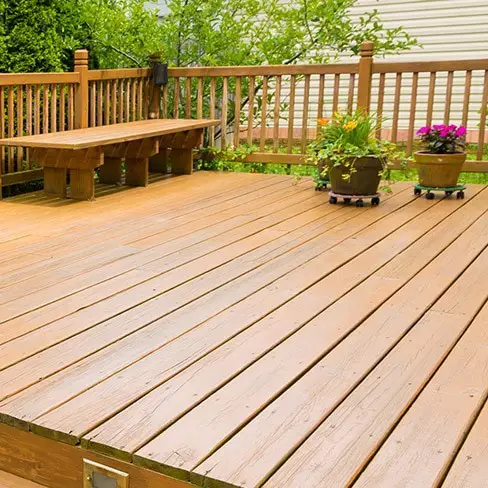
If you are thinking of using composite wood, we have made up a list of pros and cons to help you cut your research time down.
Reasons To Pick Composite Wood For Decking:
Composite wood’s advantages are,
1. Longevity
Composite wood is a mix of wood and plastic. The benefit of such a composition is that it exponentially increases the lifespan of the wood. It is highly resistant to rot, decay and insects. It can withstand severe weather changes. To boil it down, it lasts double that of traditional wooden decking.
2. Safe
You or your family would walk/run barefoot on your deck. The good news about composite wood is that it is splinter-free. You can trust the wood and walk on it barefoot for as much time as you wish. Thanks to its structural integrity, composite wood has a low slip. No need to slow your pace on your deck during a rainy season ( Be careful, nonetheless)
3. Low Maintenance
We are busy people, we don’t get the time to spend lavishly on cleaning or maintaining our decks. Composite wood requires virtually no effort. Never has to be painted or stained.
4. Environment-Friendly
Composite wood is made of 100% recycled materials. You wouldn’t need to worry about deforestation or its effects on the environment if you are opting for this wood.
Reasons To Avoid Composite Wood
By this time, you may have perfectly learned that no wood is perfect. When it comes to composite wood, the defects are,
1. Expensive
Depending on the quality, composite wood prices range from $20 to $36 per square foot. But, weighing its longevity and comparatively fewer maintenance costs, this upfront cost can be justified.
2. Doesn’t Look Authentic
Composite wood doesn’t give an authentic natural look. Moreover, its original color cannot be changed very easily, since composite wood is permanently colored in the first place.
9. Black Locust (Sustainable)
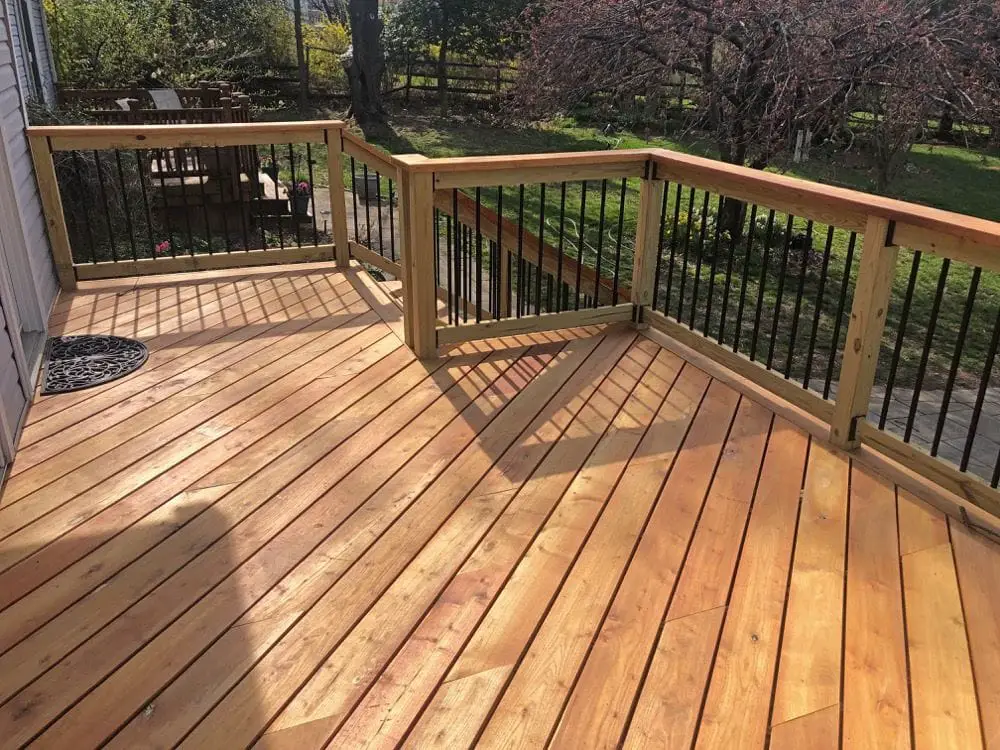
Black locust (Robinia pseudoacacia) is a wood native to Europe. It is a type of wood that is sometimes used for decking, as it is very strong and durable. It is also resistant to rot and insect damage, making it a long-lasting choice for outdoor structures.
However, Black locust is not as widely available as some other types of wood, and it can be more expensive than some other options.
Reasons To Pick Black Locust For Decking
When used as a decking material, black locust gives the advantages such as,
1. Longevity
Black locust is exceptionally long-lasting due to their inherent chemistry and dimensional stability. It can withstand decay and is resistant to decay, decomposition, abrasion, deterioration, and insects.
2. Sustainable
Compared to tropical hardwoods, a black locust is a sustainable option. It grows fast and is easy to procure.
Reasons To Avoid Black Locust:
The disadvantages of Black Locust are,
1. Difficult To Work With
Black locust, being a dense wood, is very difficult to cut, nail, and saw.
10. Cypress Wood (Durable & Affordable)

Cypress is another wood you can consider for your decking. It is also naturally resistant to decay, making it a good choice for outdoor structures.
Cypress wood has a distinctive grain and color, with a yellowish-tan to reddish-brown hue. Some common varieties of cypress include bald cypress and southern cypress.
Overall, Cypress can be a good option for decking if you want a strong, durable, and affordable wood. We’ll walk you through the pros and cons of this wood.
Reasons To Pick Cypress Wood
The advantages are,
1. Aesthetics
The yellowish-brown tone of the cypress is appealing to many.
2. Durable & Rot-Resistant
Cypress is a long-lasting wood. Cypress contains natural oils and resins which give a high resistance to rot & moisture.
3. Easy To Work With
Like all other softwood, cypress has a low density which makes it very easy to work with.
4. Affordable
It only costs around $6 to $9 per square foot. Compared, to pine or oak, this wood is cheap
Reasons To Avoid Cypress Wood
And, the disadvantages are,
1. Toxic & Odor
Cypress has respiratory & skin irritation properties. It also has a distinct odor which some users may not find pleasant
2. Fragile
Cypress wood is prone to denting due to its low density.
Frequently Asked Questions
Conclusion
The decking material is a personal preference and choice. At the end of the day, you are the person who will be enjoying a perfect summer day or rainy day out on your outdoor deck.
We have given you all the market options available for you to help you make your mind up. Now, the ball is in your court. What is perfect for you is what fits your needs and bill.
